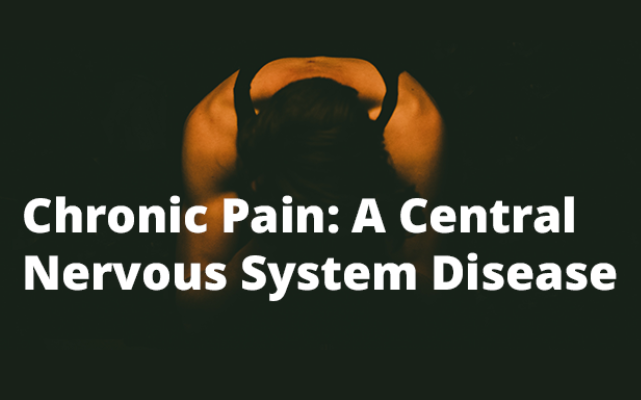When I began dating my husband, I was amazed to find that he was unable to tolerate even a mild, deep tissue massage. Any deep pressure would create a 10/10 pain experience that would last up to 5-10 minutes after my hands came off him. My husband has Ulcerative Colitis (UC) and had fibromyalgia along with extensive joint pain. At the time I did a lot of deep tissue work that helped 90% of my patients, but I could not help him.
Central Nervous System Diseases
Fibromyalgia (Fibro) is often characterized by multiple tender points throughout the body along with other symptoms such as extreme fatigue, sleep disturbances, memory difficulties, headaches, irritable bowel and mood problems.[1] A recent study, Fibromyalgia Brain Misreads Pleasure/Pain Signals, demonstrates fibro is a central nervous system (CNS) disease where the brain misreads pleasure/pain signals.[2] Other studies show a CNS issue known as central sensitization, which creates the hypersensitivity associated with the multiple tender points[3] and can also be associated with other types of chronic pain. [4] Additional studies have shown that daily aerobic and flexibility exercises are helpful in managing fibro symptoms.[5] A point made in all the studies is that people with fibro need to incorporate pain management strategies typically associated with cognitive behavioral therapies provided by a psychotherapist.[6]
As mentioned previously, chronic pain, defined as having pain longer than 3-6 months and without the multiple tender points of fibromyalgia, also has been found to have a CNS issue of hypersensitivity or central sensitization. If I treat the hypersensitive CNS and any other systems found to influence chronic pain issues, i.e. sciatic, back pain, joint pain, using gentle, non-traditional manual therapies such as Integrative Manual Therapy (IMT), my patients see faster results, with less treatment reactions, and better outcomes. In addition, I work with patients to develop an individualized exercise program to promote the integration of all involved body systems and optimize normal body function.
Treating Chronic Pain
IMT is a gentle, indirect manual therapy facilitating the whole body to heal physically, emotionally, cognitively, and spiritually. Tissue dysfunction or restrictions are found through manual diagnostics, by discerning between healthy and unhealthy motilities (rhythms) to find the source of the problem as well as treat the dysfunctional tissue. In other words, work with the restrictive tissues (tissues under tension due to dysfunction) by applying pressures in the direction of healthy tissue (tissue at ease—IMT therapy)
When I manually treat the dysfunctional CNS and other systems, i.e. GI, lymph, that maybe influencing the painful soft tissue, the patients report that the soft tissue has decreased pain. Upon re-evaluation the patient will have improved objective findings such as an increase in range of motion of nearby joints and improved balance, strength, posture, and gait.
Not until my husband was treated with IMT, did my husband’s fibro/joint symptoms turn around. With a lot of IMT, exercise, and a gluten-free diet,[7] my husband now has no joint pain, no daily fibromyalgia symptoms, and has very few UC flare-ups. In fact, I feel that by using IMT techniques I could help that remaining 10% of people that couldn’t be helped with more traditional manual therapies.
[1] Fibromyalgia A Clinical Review. Daniel J. Clauw, MD JAMA. 2014;311(15):1547-1555. doi:10.1001/jama.2014.3266.
[2]Fibromyalgia brain misreads pleasure/pain signals Arthritis Rheum. Published online November 5, 2013 Medscape Medical News
[3]Alonso-Blanco C, Fernandez-de-Las-Penas C, Morales-Cabezas M, Zarco-Moreno P, Ge HY, Florez-Garcia M. Multiple active myofascial trigger points reproduce the overall spontaneous pain pattern in women with fibromyalgiz and are related to widespread mechanical hypersensitivity. Clin J Pain. Jun 2011;27(5):405-13
[4] Central Sensitization: Implications for the diagnosis and treatment of pain. PAIN Volume 152, Issue 3, supplement, pages S2-S15, March 2011
[5]Gowans SE, Dehueck A, Silaj A, et al. Siz-month and one-year followup of 23 weeks of aeorbic exercise for individuals with fibromyalgia. Arthritis Rheum. 2004;Dec 15;51(6):890-8.
[6]Bennett R, Nelson D. Cognitive beharioral therapy for fibromyalgia. Nat Clin Pract Rheumatol. Aug 2006;2(8):416-24.
[7]Clinical impact of a gluten-free diet on health-related quality of life in seven fibromyalgia syndrome patients with associated celiac disease. Luis Rodrigo, Ignacio Blanco, Julio Bobes and Frederick J de Serres BMC Gastroenterology 2013, 13:157







Great article and references, Denise.
thanks Sally
Hey there! I’m at work surfing around your blog from my new iphone!
Just wanted to say I love reading your blog and look forward
to all your posts! Carry on the outstanding work!